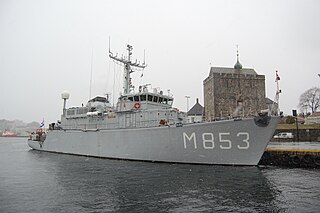
The Netherlands Armed Forces are the military services of the Kingdom of the Netherlands. The core of the armed forces consists of the four service branches: the Royal Netherlands Navy, the Royal Netherlands Army, the Royal Netherlands Air Force and the Royal Netherlands Marechaussee. The service branches are supplemented by various joint support organisations. In addition, local conscript forces exist on the Dutch Caribbean islands of Aruba (AruMil) and Curaçao (CurMil). These operate under the auspices of the Royal Netherlands Navy and the Netherlands Marine Corps. The armed forces are organisationally part of the Ministry of Defence.
The Royal Netherlands Navy is the naval force of the Kingdom of the Netherlands. It is one of the four Netherlands Armed Forces. It was founded on 8 January 1488, making it the third-oldest naval force in the world.
A hydrographic office is an organization which is devoted to acquiring and publishing hydrographic information.

HNLMS Walrus (S802) was a Walrus-class submarine of the Royal Netherlands Navy. After a long delay following a serious fire during construction, the submarine entered service in 1992. Walrus was deployed both for naval exercises and in combat operations around the world. She was decommissioned in October 2023.

HNLMS Karel Doorman is a multi-function support ship for amphibious operations of the Royal Netherlands Navy, which is also used by the German Navy. The ship replaced both of the navy's replenishment oilers: HNLMS Zuiderkruis and HNLMS Amsterdam. At 204.7 m she is the largest ship in service with the Royal Netherlands Navy.

HNLMS Rotterdam is the lead ship in the Rotterdam-class landing platform dock of the Royal Netherlands Navy. The ship is named after the Dutch city of Rotterdam.

The Alkmaar class is a ship class of fifteen minehunters that were built in the Netherlands for the Royal Netherlands Navy. They are based on the design of the Tripartite class, which was developed by a collaborative effort between the Netherlands, Belgium and France, and replaced the minesweepers and minehunters of the Dokkum class.

HNLMS Poolster was a replenishment ship serving with the Royal Netherlands Navy. Poolster entered service on 29 June 1964. In 1994 she was decommissioned and sold to the Pakistan Navy where the ship was renamed Moawin. A later replenishment ship Zuiderkruis was based on Poolster. In the Dutch navy she was replaced by the replenishment ship Amsterdam. She was the first ship in the Dutch navy with inbuilt protection against radioactive fallout.

HNLMS Mercuur (A900) is a submarine support ship of the Royal Netherlands Navy. The ship was built and designed specially to support the Dutch submarines. She entered service on 21 August 1987, and is the only surface vessel attached to the Dutch submarine service.

The Roofdier class was a class of six frigates that were built in the United States as Patrol Craft Escorts (PCE) for the Netherlands. The frigates were loaned to the Royal Netherlands Navy as part of the Mutual Defense Assistance Act (MDAP) and from 1954 to 1984 served as the Roofdier-class frigates.

HNLMS Bruinvis (S810) is a Walrus-class submarine of the Royal Netherlands Navy. She entered service in 1994 as the fourth and final submarine of the Walrus class, after HNLMS Walrus, Zeeleeuw and Dolfijn. Bruinvis has been deployed both for naval exercises and in combat operations around the world. As of December 2015 the submarine was in active service.

HNLMS Holland is the first ship of the Holland-class offshore patrol vessels of the Royal Netherlands Navy. The ship was originally designed to fulfill patrol and intervention tasks against lightly armed opponents, such as pirates and smugglers. However, it also has very advanced electronic and radar surveillance capabilities which are used for military stabilization and security roles, short of outright war. Without sonar or long range weapons, it utilizes the surveillance capabilities of the Thales integrated mast, which integrates communication systems and two 4-faced phased arrays for air and surface search.
In April 2018, the Dutch Government approved a multi-year investment program for the Dutch Navy and allocated funds for the 2018–2030 period. The Dutch Defence Materiel Administration (DMO) is in charge of the procurement of these new ships.

The Snellius class are two hydrographic survey vessel (HOV) ships in service with the hydrographic branch of the Royal Netherlands Navy. The ships were built by the Damen Group, with the hull being built in Romania by Damen Shipyards Galați and the fitting out in the Netherlands by Damen Schelde Naval Shipbuilding.

The Buyskes class was a class of two hydrographic survey vessels that were part of the Dutch Hydrographic Service of the Royal Netherlands Navy. Together with HNLMS Tydeman the ships of this class were the main ships of the Dutch Hydrographic Service during the last quarter of the 20th century. While the ships of the Buyskes class were built for performing hydrographic research, the Tydeman was focused on oceanography.
HNLMS Wamandai (A870) was a tugboat of the Royal Netherlands Navy (RNN). She was built in the Netherlands and served between 1962 and 1985 in the RNN.

HNLMS Rigel was a multi-purpose steamship of the Government Navy that could also be used as minelayer and as yacht for the Governor-general of the Dutch East Indies. The ship was militarized in 1939 and taken into service of the Royal Netherlands Navy, where it served as minelayer between 1939 and 1942.

The Snellius class was a ship class of two hydrographic survey vessels that were built in the Netherlands for the Royal Netherlands Navy. They were specially designed to be able to conduct surveys under tropical conditions.

HNLMS Zeefakkel was a hydrographic survey vessel built in the Netherlands for the Royal Netherlands Navy. She was specially designed to perform surveys in coastal areas and did this between 1951 and 1972. Later she was turned into a training vessel.
















